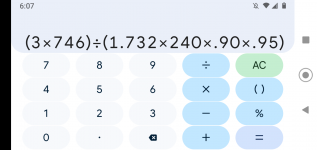How many amps does a 3-hp, 240v, 3-Phase motor draw if the motor has 90% efficiancy & a power factor of 95%?
I started with looking up the FLA = 9.6 in table 430.250
Then 9.6 / 75% = RLA (7.2)
Next 7.2 x 90% x 95% = 6.156 amps
The correct answer was 6.3
I know I'm close, but where am I off?
I started with looking up the FLA = 9.6 in table 430.250
Then 9.6 / 75% = RLA (7.2)
Next 7.2 x 90% x 95% = 6.156 amps
The correct answer was 6.3
I know I'm close, but where am I off?


